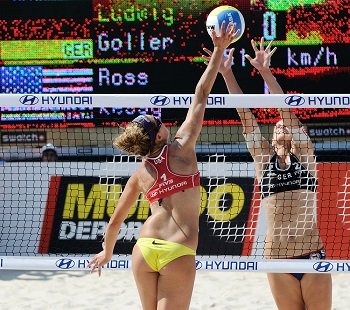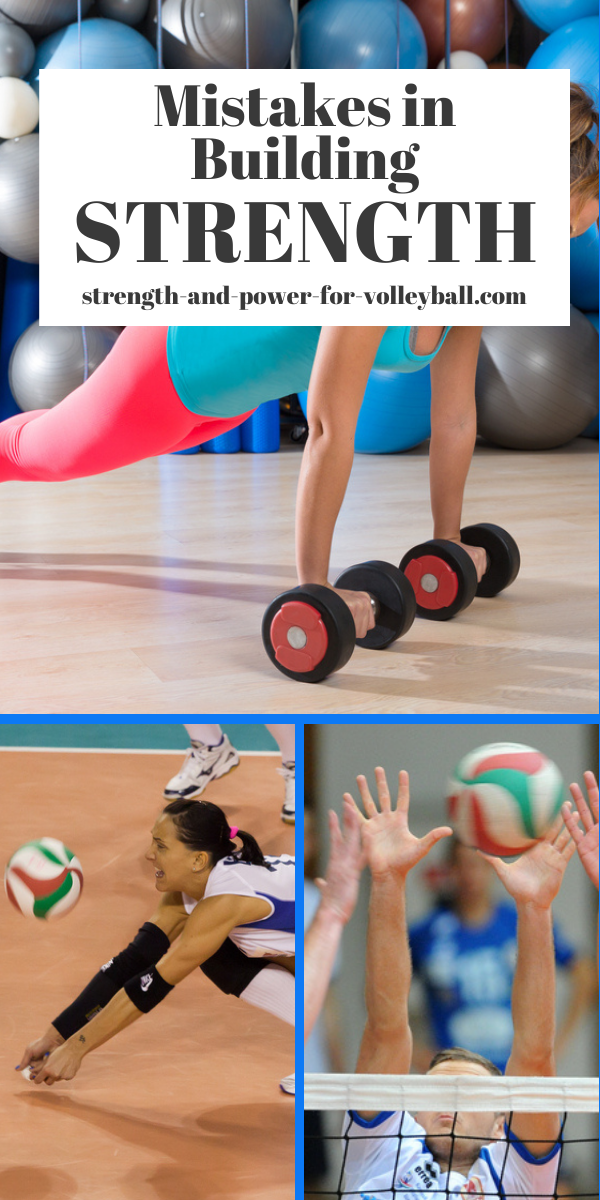- Home
- workout for volleyball
- strength for volleyball
Strength for Volleyball Myths
The following are common myths of increasing strength for volleyball.
Myth #1 HEAVY WEIGHTS MAKE ME BULKY
Myth: "I don't want to lift heavy weights because I'll get bulky."
Myth: "Lifting weights is for guys. If I lift too much I'll start looking like a man."
Developing a big, muscular, bulky body isn't easy.
If anything, it's an insult to all those people spending years in the gym in
order to look the way they do. They didn't create the body they have overnight,
which is what you're assuming if you think volleyball weight training will make
you big and bulky.
The reality is it takes years of consistent training to develop a body like a competitive bodybuilder.
Unless you're some sort of genetic freak, you have to go through more than just a few
weight training cycles
to get big and muscular.
Obviously, increasing muscle size isn't necessarily your main goal when it
comes to increasing your volleyball performance.
Creating a masculine look by putting on a ton of muscle shouldn't be the only
fear teenage girls that play volleyball have. Extra weight will likely affect their
volleyball performance on the court in a negative way.
For most players, increasing size is likely going to hurt performance.
The best volleyball athletes on the court aren't typically the biggest athletes.
The quickest players and "biggest leapers" are typically the ones that are pound for pound
the quickest, strongest, and most explosive athletes.
In the 1960's, Bruce Lee was widely regarded as one of the world's premier martial artists.
Lee was incredibly strong for his size, especially for only 145 pounds.
There are stories about him doing two-finger push-ups on one hand and
also doing them horizontally holding up a 125-pound barbell.
You could say, pound for pound, Lee may have been one of the strongest men in the world, and most certainly one of the quickest.
Heavy Weights, Low Reps, High Intensity
If you follow the philosophy of lower reps at higher intensities,
you won't likely put on a great deal of muscle mass because to get big,
you need a high training volume (high reps, high sets,
and many
exercises that work the same muscle groups).
To get strong without the bulk, you need to lift heavy weight using fewer repetitions with less
total volume.
Bodybuilding vs. Volleyball Strength Training
Bodybuilding is more closely
related to training for increased muscular endurance.
To add bulk, bodybuilders lift lighter weight at lower intensities (ie:
50% 1RM) with higher number of reps and sets (ie: 4 sets of 12
to 15 reps per exercise) with less rest between sets (ie: 30 to 90
seconds). Total volume (sets X reps X weight) for the workout is much
higher
than building strength for volleyball.
Therefore, a bodybuilding program is much different from volleyball training programs whereas the goal for volleyball is to increase
muscular strength and power
and not necessarily muscular endurance.
If you enjoyed these workout tips and would like to keep it close to you at any time, just save this pin to your Pinterest Volleyball Strength Training Board.
Myth #2 BUILDING STRENGTH FOR VOLLEYBALL ISN'T FOR GIRLS
Myth: "Weight training is only for big strong athletes such
as bodybuilders and football players."
Myth: "Women can't benefit from weight training."
Women can get strong, muscular, and fit while staying incredibly attractive and feminine.
Most women have a much lower level of testosterone than men, approximately 10 times less.
Since testosterone is known to increase protein synthesis
and muscle size, it makes sense it's much more difficult for women to
build huge muscles compared to men when using intense strength training.
There's no reason for women to be afraid of lifting heavy weights and using the
stereotypical male/macho exercises such as the deadlift, squat, and power clean.
For women (or men) that are less trained, neural factors have a huge impact on strength for volleyball gains
when first learning to lift weights. For a woman that's untrained (an inexperienced
lifter), strength increase is more neurological, that is, your increase in strength is
more directly the result of your body learning the movement patterns of the lifts.
Basically, if you're a beginner lifter, your increase in strength will
be much more due to neurological efficiency rather than increased muscle
size.
Volleyball is a sport where it's important to get stronger and not necessarily put on a lot of weight.
For example, in order to make quick movements and jump high, the extra weight
you put on must be compensated by an increase in
power or else it
will slow you down and lower your vertical jump.
If you are an untrained athlete, it would be smart to strength train because you would experience great gains in strength
neurologically without
adding a lot of muscle mass.
In fact, if you are untrained, you will increase in
strength much more rapidly than athletes that are trained. It is common for
athletes new to improving strength for volleyball lifting to notice great gains in strength from workout to
workout.
Myth #3 MUSCLE TURNS TO FAT
Myth: "I don't want to put on muscle because when I stop working out, the muscle will turn to fat."
If you stop lifting weights, the muscles you've been training will lose volume.
You
still have the same number of muscle cells, but each muscle cell is
smaller.
If you keep consuming the same amount of calories as you did during
your training, the fat cells (which were always there) will likely expand.
Muscle and fat are two completely different types of tissue, so it's physiologically impossible for one to turn into the other.
However, if you stop training, you may lose the solid muscle tone look.
If you don't adjust your diet and workout after you quit weight
training, you will likely
put on fat due to the excess calories.
Myth #4 WEIGHT TRAINING WON'T HELP WITH WEIGHT LOSS
Myth: "The only way to burn fat is to do aerobic exercise."
By gaining muscle mass from weight training, you will burn more calories.
Studies have estimated that for each pound of muscle that you add to
your body, you burn an additional 35 to 50 calories per day.
So, if you put on 5 pounds of muscle, you will burn approximately 175 to 250
more calories a day.
A pound of fat is roughly equal to 3,500 calories.
Having this extra 5 pounds of muscle on your body could allow you to burn
calories roughly equal to a pound of fat every 14 to 20 days without making any other changes.
Building strength for volleyball also has a great benefit to your metabolism. Researchers
have discovered that basal metabolic rate is increased by about 15%
from weight training. This metabolic effect is due to muscle being
metabolically active.
Muscle burns more calories than other body tissue even when you're not moving.
If done right, volleyball weight training can be used to lose weight (burn fat).
Volleyball Conditioning for Weight Loss
Basically, the "meat" of a properly designed volleyball weight training
program is made up of multi-joint resistance training exercises (squats,
deadlifts, etc).
Multi-joint exercises are not only great for improving strength for volleyball and athletic performance, but
are also great because they work nearly every muscle in your body.
What's great for fat loss is the anaerobic nature of multi-joint exercises.
Play in volleyball isn't continuous. Volleyball players need to be able
to make quick explosive movements. Volleyball consists of plays that
last on average between 5 and 15 seconds with rest between plays.
Therefore, the type of training volleyball players need is the kind of
conditioning that allows them to anaerobically move fast and jump high.
Anaerobic endurance or anaerobic power is the conditioning volleyball
players should focus on.
High Intensity Interval Training for Fat Loss
The goal of high intensity interval training is to work
every muscle group hard, frequently, and with an intensity that creates a
massive metabolic disturbance that leaves your body's metabolism
elevated for several hours post-workout.
This is known as the "afterburn effect".
It's called afterburn because
you burn calories up to 48 hours (or even longer) after your workout.
This is much different than traditional cardio aerobic exercise.
With aerobic exercise, you only burn fat during exercise. With high intensity interval training, you can
alter your metabolism in a way that will even allow you to burn calories while you sleep!

